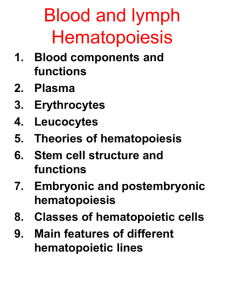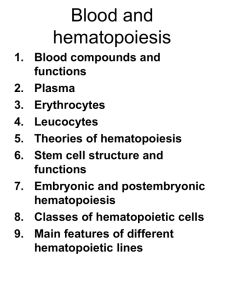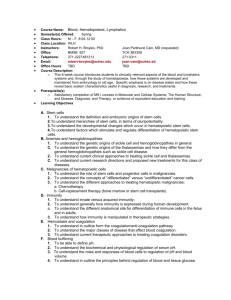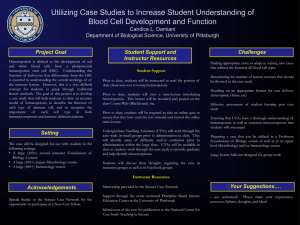Normal Haemopoiesis
advertisement
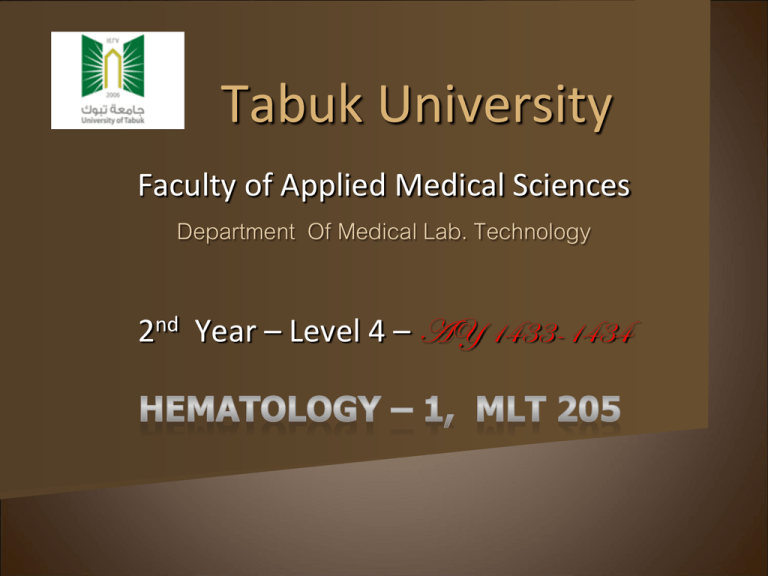
Tabuk University Faculty of Applied Medical Sciences Department Of Medical Lab. Technology 2nd Year – Level 4 – AY 1433-1434 Normal Haemopoiesis إنتاج خاليــا الدم Mr. Waggas Elaas, M.Sc, MLT References 1. 2. 1. 2. 1. 1. 2. 3. 4. 5. For theory : Essential Haematology, John Wiley & Sons Ltd ,6th Edition,Victor Hoffbrand. Harmening, Denise. (2009) . Clinical Hematology and Fundamentals of Hemostasis. 5th Edition, F. A. Davis Company For practical : Practical Haematology, Churchill Livingstone, Eighth edition, John V. Dacie, S. M. Lewis, Fischbach and Dunning. (2009). A Manual on Laboratory Diagnostic Tests. 8th Edition. Wolters Kluwer Health Lippincott Williams and Wilkins, PA ATLAS: Carr and Rodak. (2008). Clinical Hematology. 3rd Edition, Saunders/Elsevier Internet site(s): http://www.essentialhaematology6.com/default.asp = MCQs http://www.hematologyatlas.com/ http://pathy.med.nagoya-u.ac.jp/atlas/doc/atlas.html http://themedicalbiochemistrypage.org/ http://www.bloodline.net/ 3 Marks Final Theoretical exam : 40 Final Practical exam : 20 (including written questions) 1st Periodic exam : 10 theory, 5 Practical 2nd Periodic exam : 10 theory, 5 Practical Homework and class activities : 5 Theory, 5 Practical Total : 100 4 Objectives 1. 2. 3. 4. 5. To introduce Hematology to the students as a new science. To identify blood components and the function of each. To know the sites of Hemopoiesis (blood production). To know the different stages of cell production of each cell linage. To be able to differentiate between blood cells especially white cells. 5 What is hematology? Hematology is the study of blood which is composed of plasma (55%), and the formed elements which are: – The erythrocytes (RBCs) (44%) Contain hemoglobin Function in the transport of O2 and CO2 – The Leukocytes (WBCs) and platelets (thrombocytes) (1%) Leukocytes are involved in the body’s defense against the invasion of foreign antigens. Platelets are involved in hemeostasis which forms a barrier to limit blood loss at an injured site. 6 Functions of blood : 1.Transports O2 and Co2 between tissues. 2. Transports nutrients (Glucose, vitamins ..etc). 3. Take waste products such as lactic acid away from the muscles ; and urea from the liver to the kidneys. 4. Maintain body temperature. 5. Defense – White blood cells. 6. Coagulation. 7 Hematopoiesis = Hemopoiesis Hematopoiesis is a term describing the formation and development of blood cells. Hematopoiesis in the bone marrow is called Medullary hematopoiesis. Hematopoiesis in areas other than the bone marrow is called Extramedullary hematopoiesis 8 Sites of Haemopoiesis Fetus : 0 – 2 months Yolk sac 2 – 7 months Liver 5 – 9 months Bone marrow Liver and spleen continue to produce cells until 2 weeks after birth. In infancy, all the B.M is hemopoietic with progression to fatty tissues. – Gradual replacement of active (red) marrow by inactive (fatty) tissue (50% of hemopoietic B.M in adults is fatty tissues) – Expansion can occur during increased need for cell production 9 In adult life, hemopoietic B.M is restricted to central skeleton – proximal ends of femurs ( )عظم الفخذand humeri.()عظم العضد Hemopoiesis can extend to long bones. Liver & spleen can resume hemopoiesis = Extramedullary Hemopoiesis. 10 First cell : Pluripotential Stem Cell (PCS) Appear like small Lymphocyte. Rare in B.M : 1 in every 20 million nucleated cell. Self – renewal capacity B.M cellularity remain constant. Hemopoietic progenitors : When stem cells differentiate 11 1st progenitor cell : CFU-GEMM Colony Forming Unit – Granulocyte, Erythrocyte, Monocyte, Megakaryocyte stem cell (self – renewal) Stem cell divide Committed stem cell (progenitor) differentiation & division 12 Stem cells are linked with Stromal cell (adipocyte, fibroblast, endothelial cells, macrophages). 13 Stromal cells secrete substances needed by stem cell to survive . ( collagen, fibronoectin, growth factors). Growth factors are hormones that regulate proliferation & differentiation of cells. 14 Erythropoiesis and erythrocytes Lifespan of Red cells – 120 days Non nucleated Biconcave disc Production regulated by Erythropoietin Needs Fe, B12, folate & other elements for development. 15 16 CFUe the first recognizable cell in this lineage. Large cell with dark blue cytoplasm, central nucleus and nuclei and slightly clumped chromatin. The cytoplasm stains paler blue as it loses its RNA and protein synthesis apparatus and nuclear chromatin becomes more condense. The nucleus is finally extruded from the late normoblast with in the marrow and reticulocyte are formed which still contains RNA and still can synthesize hemoglobin. 17 18 WBCs = Leucocytes Phagocytes (granulocytes +monocytes) - Immunocytes (lymphocytes) Neutrophils (polymorphs) Eosinophils Basophils Monocytes 19 20 Leucopoiesis Myeloblast Promyelocyte myelocyte Metamyelocyte Band/stab/juvenile Neutrophil Neutrophil 21 22 Monocyte: Monoblast (myelomonblast) promonocyte Monocyte Macrophage (in tissues) 23 Lymphopoiesis Primary lymphoid organs (lymphocytes develop) Bone marrow Thymus Secondary lymphoid organs (specific immune responses are generated) Lymph nodes Spleen Lymphoid tissues Lymphocytes according to size : small & large lymphocytes according to immunity : T & B lymphocytes 24 B cells mature in the bone marrow and circulate in the peripheral blood until they undergo recognition of antigen. The B-cell receptor is membrane-bound immunoglobulin and after activation this is secreted as free soluble immunoglobulin. At this point they mature into memory B cells or plasma cells T cells develop from cells that have migrated to the thymus where they differentiate into mature T cells during passage from the cortex to the medulla. 25 Thrombopoiesis Platelets play a major role in primary hemostasis, Life span 7-10 days. Small discoid non nucleated. Produced in B.M by fragmentation of cytoplasm of megakaryocytes. Megakaryocytes undergoes endomitotic division = DNA replication without nuclear or cytoplasmic division. One megakaryocyte gives 1000 – 5000 plts Thrombopoietin hormone (produced by liver & kidney) is the main regulator. 26 Stem cell megakaryoblast promegakaryocyte megakaryocyte platelets 27 28 Homework-1 1. List the organs or systems involved in adult hematopoiesis. 2. Describe a "pluripotent cell". 3. Define the following terms: a. erythropoiesis b. granulopoiesis c. lymphopoiesis d. megakaryopoiesis 4. Differentiate between a monocyte and a macrophage. 5. The hematopoietic stem cell is capable of : a-Replication b-Differentiation c-Replication and differentiation 6. The process of hematpoiesis under the control of: a- Growth hormone b- Hematopoietic growth factorsc c- Thyroid hormone 29
